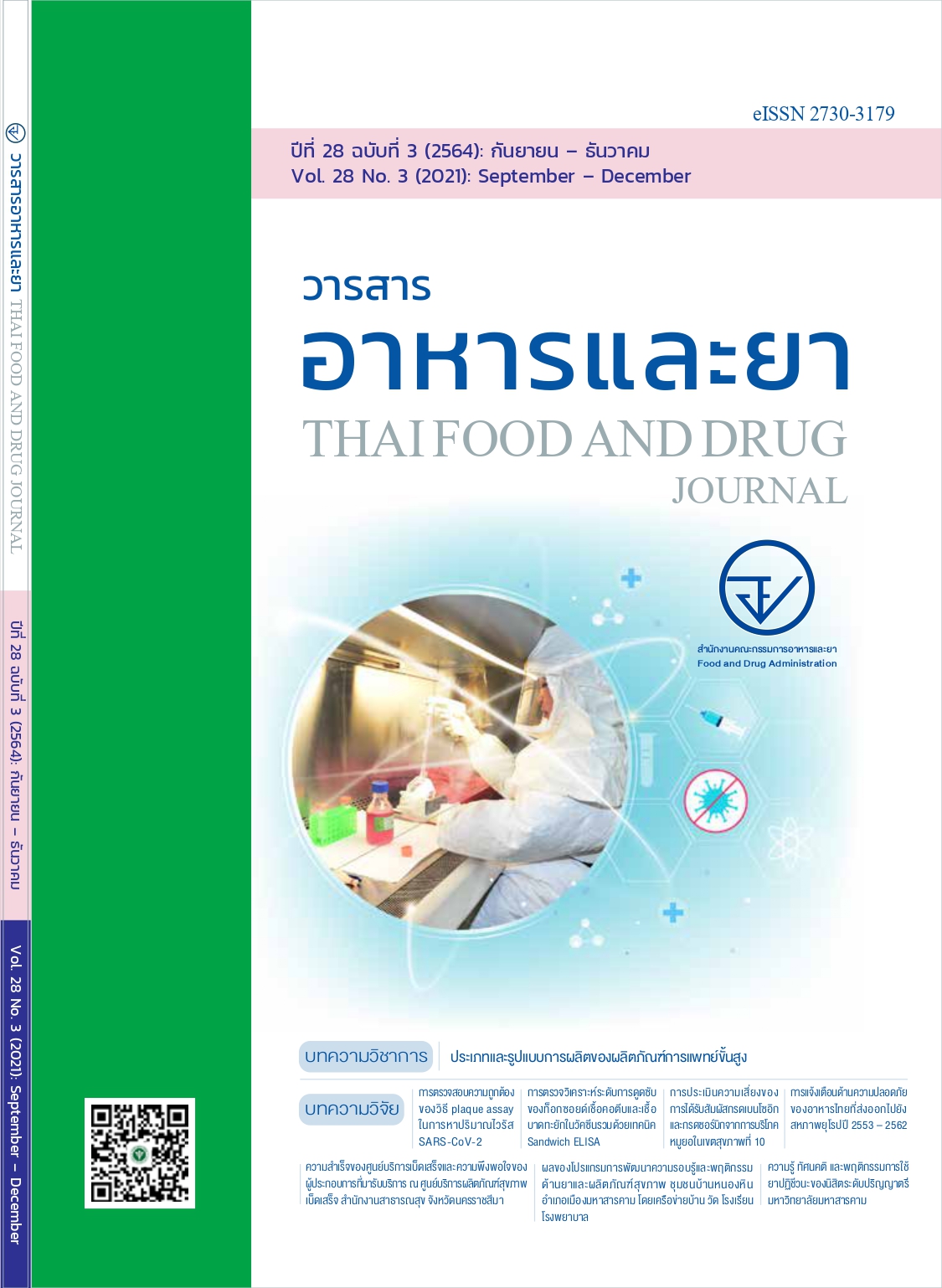Knowledge, Attitude, and Antibiotics Use Behaviours of Undergraduate Students, Mahasarakham University
Main Article Content
Abstract
Background: Improper use of antibiotics is a leading cause of antibiotic resistance in Thailand.
Objectives: This research aims to study antibiotics use behaviours and the relationship between knowledge, attitude and antibiotics use behavior among undergraduate students, Mahasarakham University.
Methods: Stratified random sampling was used to recruit participants. The participants were 120 undergraduate students, academic year 2020. Data were collecting by a questionnaire that was divided into four parts: (1) demographic data (2) knowledge of antibiotics use (3) attitude of antibiotics use and (4) antibiotics use behavior. All items had IOC values of 1.00. According to the reliability the knowledge part was tested by the Kuder-Richardson method 0.70 and the attitude and behaviours part were used Cronbach’s Alpha (0.75 and 0.86 respectively). Data were analyzed using descriptive statistics and Spearman rank-order correlation coefficient.
Results: The results revealed that the mean score for antibiotics use behavior was at good level and knowledge and attitude were significantly positively correlated to antibiotics use behavior and statistically significant with the level of p-value < 0.01 (rs =0.436, and 0.480 respectively)
Conclusions: Universities should develop rational antibiotic use learning programs or training courses for improving undergraduate students' knowledge and attitude of rational antibiotic use. Thus, undergraduate students can use antibiotics appropriately and have good health outcomes
Article Details

This work is licensed under a Creative Commons Attribution-NonCommercial-NoDerivatives 4.0 International License.
References
Biedenbach D, Bouchillon S, Hackel M, Hoban D, Kazmierczak K, Hawser S, et al. Dissemination of NDM metallo-beta-lactamase genes among clinical isolates of enterobacteriaceae collected during the SMART global surveillance study from 2008 to 2012. Antimicrob Agents Chemother 2015; 59:826-830.
Hayajneh WA, Hajj A, Hulliel F, Sarkis DK, Irani-Hakimeh N, Kazan L, et. al. Susceptibility trends and molecular characterization of gram-negative bacilli associated with urinary tract and intra-abdominal infections in Jordan and Lebanon: SMART 2011-2013. Int J Infect Dis 2015;35:56-61.
Morrissey I, Hackel M, Badal R, Bouchillon S, Hawser S, Biedenbach D. A review of ten years of the study for monitoring antimicrobial resistance trends (SMART) from 2002 to 2011. Pharmaceuticals (Basel) 2013;6:1335-1346.
James H, Handu SS, Al Khaja KA, Otoom S, Sequeira RP. Evaluation of the knowledge, attitude and practice of self-medication among first-year medical students. Med Princ Pract 2006;15:270-275.
ภัทร์อนงค์ จองศิริเลิศ, นุชน้อย ประภาโส. การประเมินผลสัมฤทธิ์ขั้นที่ 1 ของการพัฒนาระบบบริการสุขภาพให้มีการใช้ยาอย่างสมเหตุผลของโรงพยาบาลในสังกัดสำนักงานปลัดกระทรวงสาธารณสุข. วารสารเภสัชกรรมคลินิก 2560;23(1):1-12.
สุวัฒน์ ปริสุทธิวุฒิพร, มัณฑนา เหมชะญาติ. ปัจจัยที่มีผลต่อพฤติกรรมการใช้ยาปฏิชีวนะของผู้รับบริการในโรงพยาบาลขลุง จังหวัดจันทบุรี. วารสารศูนย์การศึกษาแพทยศาสตร์คลินิก โรงพยาบาลพระปกเกล้า2557;31(2):114-126.
กานนท์ อังคณาวิศัลย์, พศวัต พึ่งเกียรติไพโรจน์, นวลนิตย์ แปงดี, สคณรัช ทองคำคูณ, กัลยรัตน์ วิไลวงศ์เสถียร, พิรญาณ์ เพียรกลิ่นธรรม, และคณะ. ความรู้และความตระหนักเกี่ยวกับการใช้ยาปฏิชีวนะอย่างสมเหตุผลของนักศึกษาชั้นปีที่ 1 มหาวิทยาลัยมหิดล ปีการศึกษา 2554. วารสารวิจัยระบบสาธารณสุข2555;6(3):374-381.
สรัญญ์รักษ์ บุญมุสิก, รุ่งนภา จันทรา, ชุลีพร หีตอักษร. ความรู้ เจตคติ และพฤติกรรมการใช้ยาปฏิชีวนะอย่างสมเหตุผลของนักศึกษาพยาบาลเครือข่ายวิทยาลัยพยาบาลและสาธารณสุขภาคใต้. วารสารวิจัยและนวัตกรรมทางสุขภาพ 2562;2(1):25-36.
อติญาณ์ ศรเกษตริน, นงณภัทร รุ่งเนย, นิตยา ทองมา, รัชชนก กลิ่นชาติ, เบญจพร รัชตารมย์, พรฤดี นิธิรัตน์. ปัจจัยทำนายการใช้ยาปฏิชีวนะอย่างสมเหตุสมผลของนักศึกษาพยาบาล. วารสารวิทยาลัยพยาบาลบรมราชชนนีนครราชสีมา 2562;25(1):43-59.
นัชชา ยันติ. ปัจจัยที่มีความสัมพันธ์ต่อพฤติกรรมการใช้ยาปฏิชีวนะของนักศึกษาหลักสูตรสาธารณสุขศาสตร์ มหาวิทยาลัยแห่งหนึ่ง จังหวัดปทุมธานี. วารสารวไลยอลงกรณ์ปริทัศน์ (มนุษยศาสตร์และสังคมศาสตร์) 2560;7(2):57-66.
วิลาวัณย์ อุ่นเรือน, ดลวิวัฒน์ แสนโสม. พฤติกรรมการใช้ยาปฏิชีวนะของนักศึกษามหาวิทยาลัยขอนแก่นในอาการเจ็บคอ บาดแผลสะอาด ท้องร่วง. วารสารวิจัยสถาบันมหาวิทยาลัยขอนแก่น 2558;3(3):221-232.
Faul F, Erdfelder E, Buchner A, Lang A.-G. Statistical power analyses using G*Power 3.1: tests for correlation and regression analyses. Behavior Research Methods 2009;41:1149-1160.
Bloom BS, Hastings JT, Madaus GF. Handbook on formative and summative evaluation of student learning. New York: McGaw-Hill; 1971.
Best JW, Kahn JV. Research in Education. 10th ed. United States of America: Pearson Education; 2014.
Cohen J. Statistical power analysis for the behavioral sciences. 2nd ed. Hillsdale, NJ: Erlbaum; 1988.
ณัฐพร อยู่ปาน, พัชรี ดวงจันทร์. พฤติกรรมการอ่านฉลากก่อนซื้อหรือใช้ผลิตภัณฑ์ยาและเครื่องสำอางของนิสิตระดับปริญญาตรีมหาวิทยาลัยศรีนครินทรวิโรฒ. วารสารไทยเภสัชศาสตร์และวิทยาการสุขภาพ2555;5(2):121-130.
Ngo T, Tran M, Nguyen T. Influencing factors on knowledge, attitude and behaviour towards antibiotic usage among adults In Ho Chi Minh City, Viet Nam. Value in Health 2016;19:A479.


